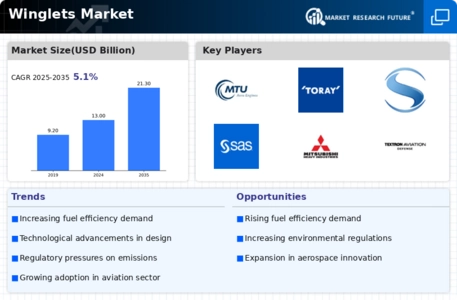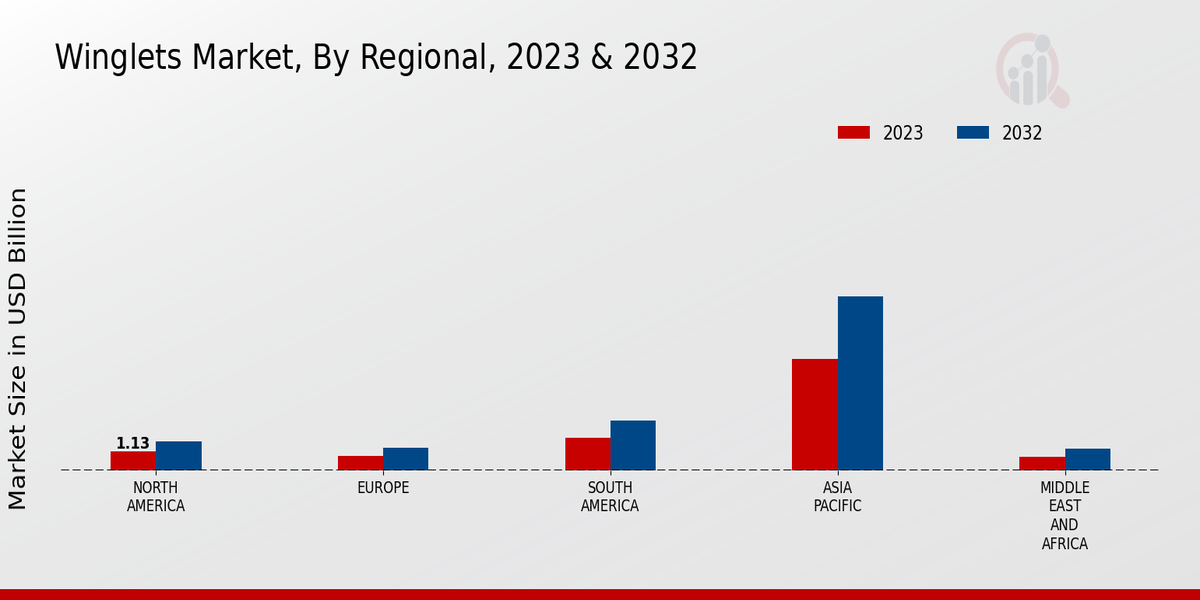Market Growth Projections
The Global Winglets Market Industry is projected to experience substantial growth over the next decade. With a market size anticipated to reach 13.0 USD Billion in 2024 and further expand to 21.3 USD Billion by 2035, the industry is poised for a promising trajectory. The compound annual growth rate (CAGR) of 4.6% from 2025 to 2035 indicates a steady increase in demand for winglet technology. This growth is driven by various factors, including the need for fuel efficiency, regulatory support, and technological advancements. As the aviation sector continues to evolve, the winglets market is likely to play a pivotal role in shaping the future of aircraft design and performance.
Expansion of the Aviation Sector
The Global Winglets Market Industry is positively influenced by the expansion of the aviation sector, particularly in emerging economies. As air travel becomes more accessible, airlines are investing in new aircraft to meet growing passenger demand. This expansion necessitates the incorporation of fuel-efficient technologies, such as winglets, to optimize operational costs. The increasing number of aircraft deliveries in regions like Asia-Pacific and Latin America is likely to drive the demand for winglet installations. Consequently, the industry is poised for growth, as airlines recognize the importance of integrating winglet technology into their fleets to enhance performance and reduce environmental impact.
Increasing Demand for Fuel Efficiency
The Global Winglets Market Industry experiences a notable surge in demand for fuel-efficient aircraft designs. Winglets, which are vertical extensions at the tips of wings, significantly reduce drag and enhance aerodynamic performance. This is particularly relevant as airlines seek to lower operational costs amidst rising fuel prices. In 2024, the market is projected to reach 13.0 USD Billion, reflecting a growing recognition of winglet technology's potential to improve fuel efficiency. As airlines increasingly adopt winglet-equipped aircraft, the industry is likely to witness a robust growth trajectory, with a projected CAGR of 4.6% from 2025 to 2035.
Technological Advancements in Winglet Design
The Global Winglets Market Industry is witnessing rapid advancements in winglet design and technology. Innovations such as blended winglets and advanced materials are enhancing the performance and efficiency of winglets. These developments enable aircraft manufacturers to produce lighter and more aerodynamically efficient winglets, which can lead to substantial fuel savings. As airlines increasingly prioritize operational efficiency, the adoption of these advanced winglet designs is likely to accelerate. This trend is expected to contribute to the market's growth, with projections indicating a market size of 21.3 USD Billion by 2035, driven by the ongoing evolution of winglet technology.
Regulatory Support for Environmental Standards
The Global Winglets Market Industry benefits from stringent environmental regulations aimed at reducing carbon emissions in aviation. Governments worldwide are implementing policies that encourage the adoption of technologies that enhance fuel efficiency and minimize environmental impact. Winglets play a crucial role in this context, as they contribute to lower fuel consumption and reduced greenhouse gas emissions. As airlines strive to comply with these regulations, the demand for winglet-equipped aircraft is expected to rise. This regulatory support not only drives market growth but also aligns with global sustainability goals, positioning the industry favorably for future developments.
Growing Focus on Aircraft Performance Optimization
The Global Winglets Market Industry is characterized by a growing emphasis on optimizing aircraft performance. Airlines are increasingly seeking ways to enhance the efficiency and reliability of their fleets, and winglets have emerged as a key solution. By reducing drag and improving lift, winglets contribute to better overall aircraft performance, which is crucial in a competitive market. As airlines strive to differentiate themselves through operational excellence, the adoption of winglet technology is likely to gain momentum. This focus on performance optimization aligns with broader industry trends, suggesting a sustained demand for winglet-equipped aircraft in the coming years.











